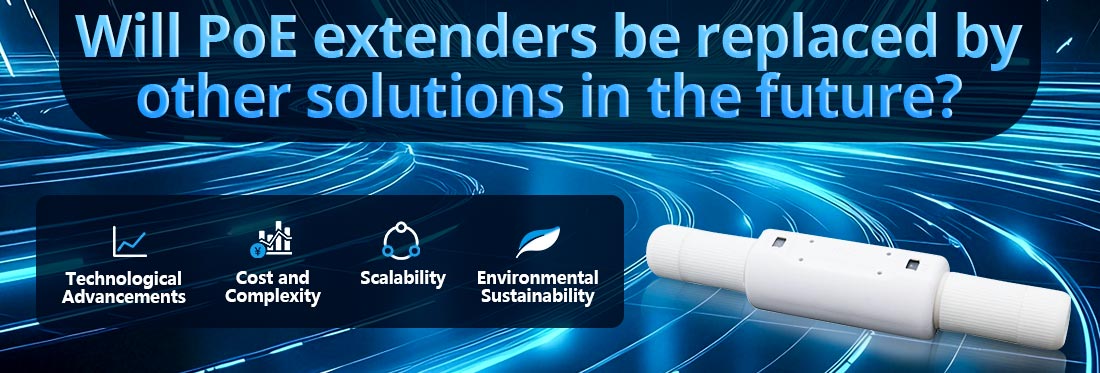
Os extensores PoE são uma solução amplamente utilizada para estender Power over Ethernet (PoE) além do limite de 100 metros (328 pés) dos cabos Ethernet padrão. No entanto, à medida que as tecnologias de rede e de fornecimento de energia avançam, soluções alternativas podem surgir ou coexistir, substituindo potencialmente os extensores PoE em determinados casos de utilização. Se os extensores PoE continuarão sendo uma solução primária ou serão substituídos depende de fatores como inovações tecnológicas, requisitos de aplicação e considerações de custo.
Descrição detalhada de alternativas potenciais
1. Redes de fibra óptica com alimentação PoE remota
Descrição:
--- Os cabos de fibra óptica oferecem transmissão de dados de longa distância sem perda de sinal. Combinado com controle remoto Injetores PoE ou midspans, esta solução pode fornecer energia e dados de alta velocidade em distâncias significativas.
Vantagens:
--- Taxa de transferência de dados extremamente alta (até terabits por segundo).
--- Imunidade à interferência eletromagnética.
--- Distâncias mais longas em comparação com extensores PoE.
Desafios:
--- Requer infraestrutura separada para fornecimento de fibra e energia.
--- Maiores custos iniciais de instalação e equipamentos.
Potencial de substituição:
--- Ideal para implantações em larga escala, como campi e cidades inteligentes, onde altas taxas de dados e longas distâncias são críticas.
2. Sistemas híbridos de fibra-PoE
Descrição:
--- Os sistemas híbridos combinam fibra óptica para dados e condutores de cobre para energia em um único cabo, ampliando o alcance e mantendo a simplicidade.
Vantagens:
--- Simplifica os requisitos de cabeamento.
--- Suporta dados de alta velocidade e fornecimento significativo de energia.
Desafios:
--- Disponibilidade limitada e custo mais elevado em comparação com o cabeamento Ethernet tradicional.
Potencial de substituição:
--- Adequado para IoT e aplicações externas, potencialmente substituindo extensores PoE para instalações de média a longa distância.
3. Soluções de energia e dados sem fio
Descrição:
--- Tecnologias sem fio como Wi-Fi, 5G e LoRaWAN podem fornecer dados, enquanto sistemas emergentes de transferência de energia sem fio podem fornecer energia aos dispositivos.
Vantagens:
--- Elimina completamente a necessidade de cabeamento.
--- Flexível e adaptável a ambientes dinâmicos.
Desafios:
--- A energia sem fio é limitada em alcance e eficiência.
--- Requer avanços significativos para atender às demandas de alta potência das aplicações PoE.
Potencial de substituição:
--- Pode complementar ou substituir extensores PoE em áreas como casas inteligentes, configurações temporárias e ambientes com cabeamento restritivo.
4. Switches PoE avançados
Descrição:
--- Alta potência Interruptores PoE com recursos de alcance estendido podem substituir diretamente a necessidade de extensores.
Vantagens:
--- Simplifica o gerenciamento de rede reduzindo componentes.
--- Pode suportar níveis de potência mais elevados e taxas de dados multigigabit.
Desafios:
--- Limitado a aplicações dentro do alcance máximo do switch.
--- Maior custo para modelos de alta potência e longa distância.
Potencial de substituição:
--- Pode substituir extensores PoE em redes centralizadas onde os switches podem alcançar todos os dispositivos sem a necessidade de extensão.
5. Padrões Ethernet de alto desempenho
Descrição:
--- Inovações em padrões Ethernet, como Ethernet de par único (SPE), visam fornecer dados e energia em distâncias mais longas com menores requisitos de infraestrutura.
Vantagens:
--- Amplia o alcance sem componentes adicionais, como extensores.
--- Custos e complexidade de cabeamento reduzidos.
Desafios:
--- Ainda em estágios iniciais de adoção e desenvolvimento.
Potencial de substituição:
--- Poderia substituir gradualmente os extensores PoE em aplicações como IoT industrial e automação predial.
6. Sistemas de distribuição de energia CC
Descrição:
--- Microrredes DC distribuem energia diretamente aos dispositivos, com Ethernet usada exclusivamente para dados.
Vantagens:
--- Altamente eficiente para fornecimento de energia.
--- Escalável para grandes instalações.
Desafios:
--- Requer infraestrutura separada de energia e dados.
--- Não tão amplamente adotado quanto PoE.
Potencial de substituição:
--- Pode substituir extensores PoE em aplicações de alta potência, como data centers e instalações industriais.
Fatores que influenciam a substituição de extensores PoE
Avanços Tecnológicos
--- Novos padrões e tecnologias poderiam tornar Extensores PoE menos necessário, abordando as limitações atuais como distância, fornecimento de energia e taxa de dados.
Custo e Complexidade
--- Alternativas econômicas com instalação e manutenção mais simples podem impulsionar a adoção de extensores PoE.
Escalabilidade
--- Soluções como redes de fibra ou sem fio oferecem maior escalabilidade, o que é fundamental para a expansão da IoT, cidades inteligentes e outros sistemas interconectados.
Sustentabilidade Ambiental
--- Alternativas ou soluções com eficiência energética que reduzem o uso de materiais (como cabeamento) podem ganhar preferência em relação aos extensores PoE tradicionais.
Conclusão
Embora os extensores PoE continuem a ser uma solução prática e amplamente utilizada, o seu papel futuro pode diminuir em favor de tecnologias emergentes, como sistemas PoE de fibra híbrida, soluções sem fios, switches avançados e padrões Ethernet de maior desempenho. Essas alternativas abordam as limitações dos extensores PoE, como restrições de alcance e energia, ao mesmo tempo que oferecem maior escalabilidade, velocidade e eficiência. No entanto, é improvável que os extensores PoE desapareçam completamente, pois continuam a fornecer uma opção simples e econômica para muitas aplicações de pequena e média escala. A sua evolução e relevância dependerão do ritmo dos avanços tecnológicos e das necessidades específicas das redes modernas.